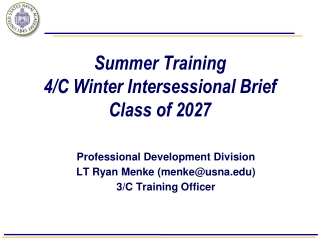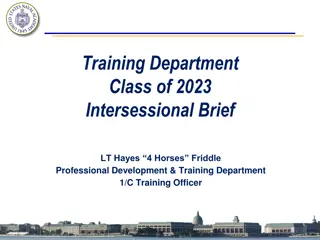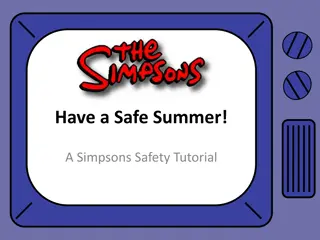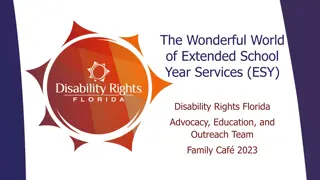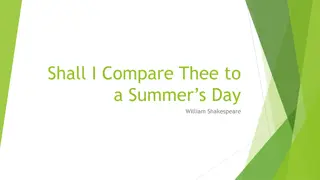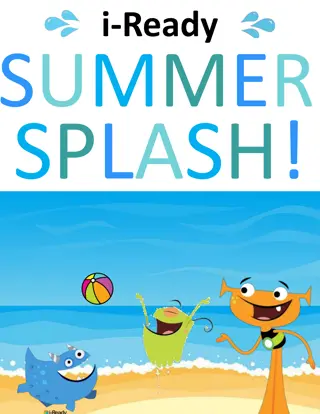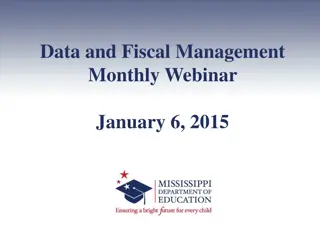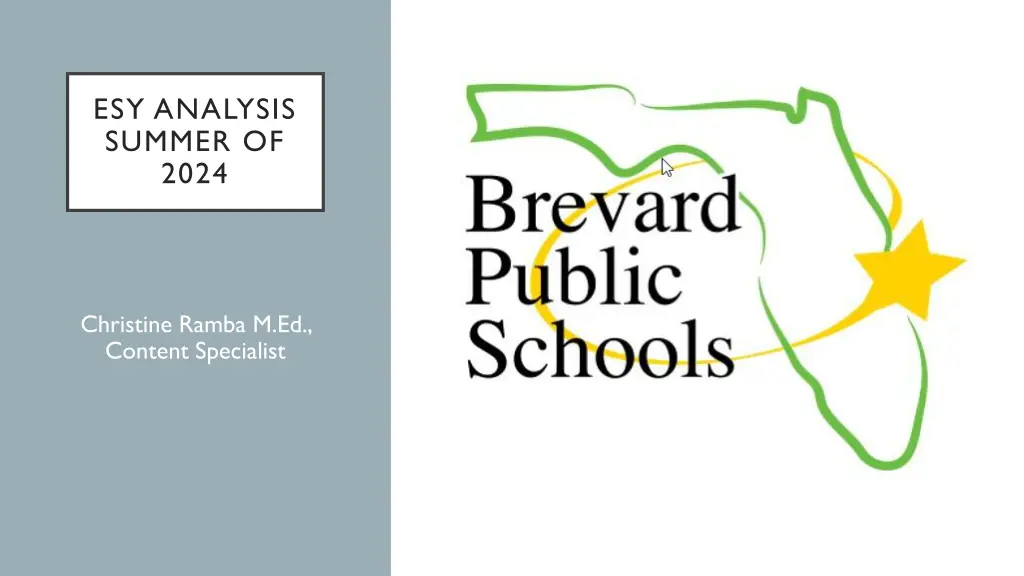
Assistance in Individual Educational Plan Decision Making for ESY Needs
"Assist IEP teams in deciding Extended School Year needs for children with disabilities as per IDEA requirements. Analysis of ESY data from elementary and secondary schools in summer 2024 reveals important insights and areas for improvement."
Download Presentation

Please find below an Image/Link to download the presentation.
The content on the website is provided AS IS for your information and personal use only. It may not be sold, licensed, or shared on other websites without obtaining consent from the author. If you encounter any issues during the download, it is possible that the publisher has removed the file from their server.
You are allowed to download the files provided on this website for personal or commercial use, subject to the condition that they are used lawfully. All files are the property of their respective owners.
The content on the website is provided AS IS for your information and personal use only. It may not be sold, licensed, or shared on other websites without obtaining consent from the author.
E N D
Presentation Transcript
ESY ANALYSIS SUMMER OF 2024 Christine Ramba M.Ed., Content Specialist
Provide assistance to Individual Educational Plan (IEP) teams making decisions about the Extended School Year (ESY) needs of each child with a disability. Based on requirement of the Individuals with Disabilities Education Act (IDEA). OBJECTIVE
ANALYSIS - ELEMENTARY School A 18% - 9 IEPs out of 51 had data to support ESY School B 25% - 7 IEPs out of 28 had data to support ESY School C 12% - 22 IEPs out of 187 had data to support ESY School D 10% - 10 IEPs out of 104 had data to support ESY School E 16% - 13 IEPs out of 81 had data to support ESY
ANALYSIS - SECONDARY School A 13% - 2 IEPs out of 16 had data to support ESY School B 8% - 1 IEP out of 12 had data to support ESY School C 40% - 6 IEPs out of 15 had data to support ESY School D 8% - 1 IEP out of 13 had data to support ESY
ANALYSIS OF DATA FROM SUMMER 2024 ESY IEPS
2024 ESY DATA SUMMARIZED The data included under ESY is almost always State/District Assessment data that has been copied/pasted from page one of the IEP. The majority of this data shows growth. A required component is to explain the team s rationale used to determine the answers to the ESY questions, this component was not included. A required component is to summarize the IEP team s discussion used to determine the answers to the ESY questions, this component was not included.
2024 ESY DATA SUMMARIZED The services on the IEP for ESY do not match the data included under ESY, for example the data does not include social emotional data, yet ESY includes the service of Very Small Group Instruction in Social Interaction. The data is just a list of what was considered, instead of quantifiable data. For example: teacher input, grades, progress reports, etc. Most IEPs did not include any goal data to support the decision for ESY.
2024 ESY DATA SUMMARIZED Data in ESY states that the student is not making progress towards their annual goals, yet when the progress report is reviewed, the student has Satisfactory progress for goals. Yes is selected for crucial stage of a critical life skill under ESY, but there is no data, summary, rationale for any specific life skill. Yes is selected for nature or severity of student s disability. Eligibility is for Language Impaired or SLD, and there is no indication or rationale provided that suggests the student needs intensive support.
Service: Assistance with Academics No description, summary, rationale. Data used shows growth.
Service: Speech Therapy Data just listed, no specific speech data to support ESY service, no summary of the data or rationale provided.
Services: Very Small Group instruction in all academics, Very Small Group instruction in social emotional. No description, summary, rationale. No data.
Services: Small group instruction in reading, Small group instruction in writing Small group instruction in math, Small group instruction in social emotional skills. No data, no summary of information considered (data), if student is making excellent growth, do they need ESY for FAPE?
Services: Assistance with Academics, Instruction in Independent Functioning skills No comparison data, no goal data, no data for Independent Functioning. Rationale states that the data does not support the need for ESY.
Services: Small group instruction in English language arts, Small group instruction in math, Instruction in Social/Emotional skills, Language Therapy, Occupational Therapy No data, no summary of information considered (data), no rationale, decision is not made based on location.
Services: Assistance with Academics in English language arts, Assistance with Academics in Math, Language Therapy. No comparison data, no goal data, no summary or rationale. For Communication it states that it cannot be determined at this time but has the service of Language Therapy.
Yes, for regression/recoupment in academics, communication, independent functioning, and social emotional. Data only academic, shows growth, and not goal data. Services on IEP for ESY:
ESY IS BASED ON DATA Clear Present Level of Education Performance statement (PLAAFP) Data: direct, on-going assessment of IEP goals, including benchmarks and short-term objectives Specially designed instruction and related services provided for the provision of FAPE
ESY IS BASED ON DATA Observable, measurable annual goals, including benchmarks and short-term objectives, are the KEY to collecting data.
ESY IS BASED ON DATA Critical life skill areas to consider: Academics (or for pre-k, developmentally appropriate pre-academic skills) Communication Independent Functioning and Self-Sufficiency Social/Emotional Development or Behavior Do the data indicate the likelihood that significant regression will occur in critical life skills and that those skills cannot be recouped within a reasonable amount of time without ESY services?
ESY IS BASED ON DATA Do the data indicate that the student is at a crucial stage in the development of a critical life skill, and a lapse in services would substantially jeopardize the student s chances of learning that skill? Is the nature or severity of the student s disability such that the student would be unlikely to benefit from his or her education without the provision of ESY services? Are there extenuating circumstances pertinent to the student s current situation that indicate the likelihood that FAPE would not be provided without ESY services?
ESY IS BASED ON DATA Data collected over the course of the school year, including before and after scheduled breaks in instruction, should be used to frame the determination of need. Choose goals to be targeted during ESY to ensure FAPE ESY services may or may not look like the traditional school year type, frequency, amount, and/or location may differ ESY services may include related services, only if appropriate
WHAT DO WE MEAN WHEN WE TALK ABOUT ?
Skills that are essential for the promotion and maintenance of the student s self-sufficiency. Skills such as toileting and eating are essential for minimal independence; stable relationships, impulse control, and appropriate peer interactions are necessary for community living. Some communication skills and academic skills such as reading may be considered critical life skills for certain students. CRITICAL LIFE SKILLS From: Florida Department of Education, Extended School Year Services for Students with Disabilities: A Guide for IEP Teams
EMERGING SKILLS Skills that the student has just begun to learn and, therefore, may not display consistently. From: Florida Department of Education, Extended School Year Services for Students with Disabilities: A Guide for IEP Teams
The degree or manner in which the disability affects the student s performance. The more severely a disability affects a student s performance or functioning, the more likely it is that breaks in instruction will adversely affect the student s learning overall. One example is a student with severe emotional disturbance who reverts to a significantly lower functioning level or who exhibits increased inappropriate behaviors when his or her program is interrupted. Another example is a student who needs intensive and concentrated work on independent functioning skills in order to maintain self-sufficiency and independence from caregivers and who needs additional or continuous support to reach his or her goals. IMPACT OF THE DISABILITY *Not every student with ASD, or significant behaviors will need ESY in order to be provided with FAPE. From: Florida Department of Education, Extended School Year Services for Students with Disabilities: A Guide for IEP Teams
The rate at which the student learns specific skills or behaviors. If, after reviewing the student s progress on IEP goals targeting critical life skills, the IEP team determines that the student s rate of progress is likely to prevent the student from receiving educational benefit from his or her program during the regular school year, ESY services may be indicated. RATE OF PROGRESS From: Florida Department of Education, Extended School Year Services for Students with Disabilities: A Guide for IEP Teams
Loss of skills during extended breaks in instruction and the period of time it takes for the student to regain those skills once instruction begins again. All students are expected to regress somewhat after a break in instruction, with a reasonable period of recoupment upon return to instruction. However, for some students with disabilities, the loss of critical life skills in one or more areas may be substantial, and the period of time required to recoup the skills may be unreasonable. REGRESSION/ RECOUPMENT From: Florida Department of Education, Extended School Year Services for Students with Disabilities: A Guide for IEP Teams
The recoupment period considered reasonable differs based on the skill or behavior in question. For example, any regression in severe self-injurious behavior would be considered significant, and the IEP team might determine that no period required for recoupment would be acceptable. Alternatively, if a student is projected to experience a three-month regression in decoding ability but is expected to recoup the skill in six to eight weeks (the time ordinarily reserved for the purpose of review at the beginning of the school year), that could be considered a reasonable period of time. REGRESSION/ RECOUPMENT From: Florida Department of Education, Extended School Year Services for Students with Disabilities: A Guide for IEP Teams
The ability to function as independently as possible. The goal of instruction related to basic life skills is to reduce the student s reliance on caregivers. SELF- SUFFICIENCY From: Florida Department of Education, Extended School Year Services for Students with Disabilities: A Guide for IEP Teams
WHAT DATA DO WE NEED FOR ESY?
DECISION-MAKING PROCESS Please select Guiding Questions
DATA, SUMMARY, RATIONALE Use this section to: 1. Describe the data reviewed. Specific goal data will go under each subsection. 2. Summarize the IEP team s discussion (summary should be added live, during meeting.) Be sure to include parent input (if attended meeting.) 3. Explain the rationale used to determine the answers to the ESY questions.
ACADEMICS REGRESSION/ RECOUPMENT If Yes or No is selected, use this section to: 1. Include SPECIFIC goal data, in the optional box, that shows regression/recoupment. 2. The IEP progress report should match the data included in this section. 3. The service(s) for ESY should align with the data inputted.
COMMUNICATION REGRESSION/ RECOUPMENT If Yes or No is selected, use this section to: 1. Include SPECIFIC goal data, in the optional box, that shows regression/recoupment. 2. The IEP progress report should match the data included in this section. 3. The service(s) for ESY should align with the data inputted.
INDEPENDENT FUNCTIONING & SELF- SUFFICIENCY REGRESSION/ RECOUPMENT If Yes or No is selected, use this section to: 1. Include SPECIFIC goal data, in the optional box, that shows regression/recoupment. 2. The IEP progress report should match the data included in this section. 3. The service(s) for ESY should align with the data inputted.
SOCIAL/EMOTIONAL DEVELOPMENT OR BEHAVIOR REGRESSION/ RECOUPMENT If Yes or No is selected, use this section to: 1. Include SPECIFIC goal data, in the optional box, that shows regression/recoupment. 2. The IEP progress report should match the data included in this section. 3. The service(s) for ESY should align with the data inputted.
A critical life skill is a behavioral, academic, social, or other skill that a student s IEP team determines is critical to allowing the student to function independently. Examples include communicating, dressing, feeding, and other self-help skills, as well as skills related to social/emotional learning and mobility. These skills may not be critical to a student s academic progress but are important for reducing dependency on caregivers in the future. EXAMPLES: CRUCIAL STAGE IN DEVELOPMENT OF A CRITICAL LIFE SKILL
CRUCIAL STAGE IN DEVELOPMENT OF A CRITICAL LIFE SKILL If Yes is selected, use this section to: 1. State what the critical life skill is that you are targeting. 2. Include data to support the need for the critical life skill. 3. The service(s) for ESY should align with the data inputted. *Include any discussion/summary in the optional box that occurred during the meeting.
Students with severe emotional disturbance - These students may revert to a lower functioning level or exhibit inappropriate behaviors when their program is interrupted. Students who need intensive support - These students may need additional or continuous support to reach their goals. EXAMPLES: Students with frequent health-related absences - These students may have significantly impeded progress on goals related to critical life skills. NATURE OR SEVERITY OF THE STUDENT S DISABILITY Students who have received therapy - These students may regress if their therapies are suspended, and it may take a long time to reach their previous level of independence. Students with autism spectrum disorder - These students may have a goal of playing with a peer during recess on at least three different types of playground equipment. Students with multiple disabilities - These students may have a goal of developing social initiation skills but live in an isolated rural area.
NATURE OR SEVERITY OF THE STUDENT S DISABILITY If Yes is selected, use this section to: 1. Describe the nature/severity that you are targeting. 2. Include data/explanation to support the decision to mark yes . 3. The service(s) for ESY should align with the data inputted. *Include any discussion/summary in the optional box that occurred during the meeting.
A student who recently obtained paid employment and requires the services of a job coach. EXAMPLES: A student who requires ESY services to remain in their current LRE and prevent movement to a more restrictive setting. EXTENUATING CIRCUMSTANCES A student whose frequent health related absences have significantly impeded progress on goals related to critical life skills.
EXTENUATING CIRCUMSTANCES PERTINENT TO THE STUDENT S CURRENT SITUATION If Yes is selected, use this section to: 1. State what the extenuating circumstance is that is pertinent to the student s current situation. 2. Include data to support the need for the critical life skill. 3. The service(s) for ESY should align with the data inputted. *Include any discussion/summary in the optional box that occurred during the meeting.
PEER HOW TO RUN ESY REPORTS ESY Determination Required Report ESY Report While in PEER select: While in PEER select: Administrative Reports Administrative Reports Extended School Year Services Determination Required (NEW) Extended School Year Services Select your school Select your school Run Report Run Report
NEXT STEPS DR. FONTAN Run PEER Reports-ESY Services Review IEPs to ensure compliance with ESY procedures Amend/Develop IEPs to meet compliance with ESY procedures Due date: March 7, 2025
NEXT STEPS DR. FONTAN All IEPs due in April and May 2025 that are being considered for ESY services need to be completed by March 14, 2025.


